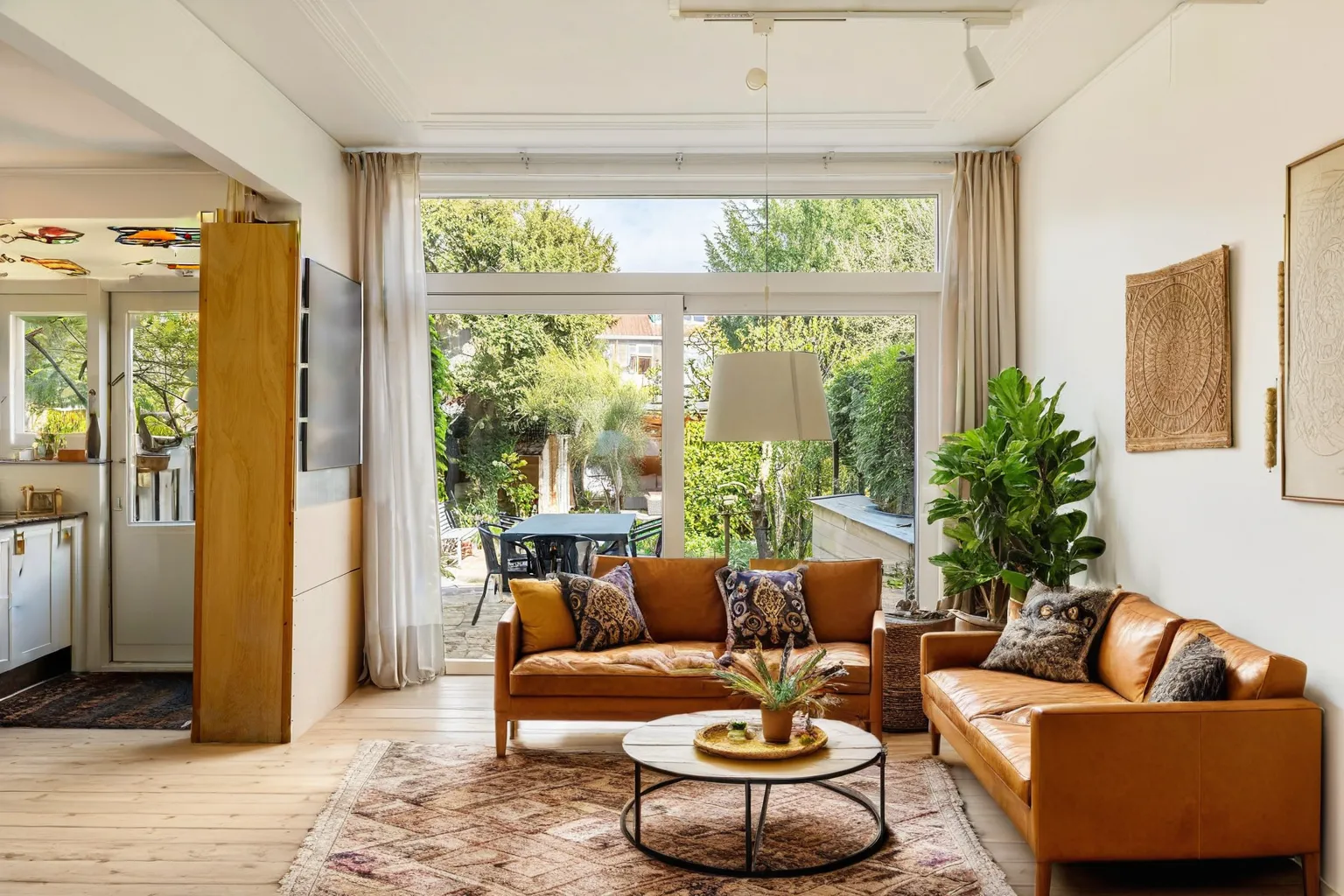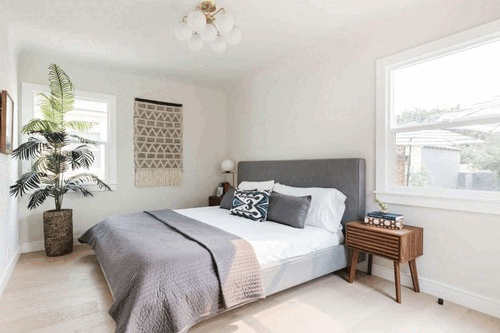comfyui-interior-remodel
Maintainer: jschoormans

7

| Property | Value |
|---|---|
| Run this model | Run on Replicate |
| API spec | View on Replicate |
| Github link | View on Github |
| Paper link | No paper link provided |
Create account to get full access
Model overview
comfyui-interior-remodel is a model developed by jschoormans that focuses on interior remodeling. It keeps key elements like windows, ceilings, and doors while using a depth controlnet to ignore existing furniture. This model can be particularly useful for visualizing changes to a room's layout and decor without disrupting the core structure. Similar models like interioraidesigns-generate, rvision-inp-slow, and interior-design also explore AI-powered interior design and remodeling.
Model inputs and outputs
The comfyui-interior-remodel model takes an image as input and generates a new image depicting an interior remodel. Users can provide a prompt to guide the model's output, as well as set parameters like output format and quality.
Inputs
- Image: An image of a room or interior space to be remodeled
- Prompt: A text description of the desired remodel, such as "photo of a beautiful living room, modern design, modernist, cozy"
- Negative Prompt: Text to exclude from the output, like "blurry, illustration, distorted, horror"
- Output Format: The format of the generated image, such as WebP
- Output Quality: The quality level of the output image, from 0 to 100
- Randomise Seeds: Whether to automatically randomize the seeds used for generation
Outputs
- Array of Image URLs: The generated images depicting the interior remodel
Capabilities
The comfyui-interior-remodel model excels at visualizing changes to a room's layout and decor while preserving key structural elements. It can be particularly useful for quickly exploring different design options without physically remodeling a space. The model's depth controlnet also helps ensure that new furniture and decor integrates seamlessly with the existing environment.
What can I use it for?
This model could be used by interior designers, homeowners, or DIY enthusiasts to experiment with remodeling ideas for a space. By inputting a photo of a room and providing a prompt, users can quickly generate realistic visualizations of potential design changes. This can help streamline the decision-making process and allow for more informed choices before undertaking a physical remodel.
Things to try
One interesting aspect of the comfyui-interior-remodel model is its ability to maintain key structural elements like windows and ceilings while still allowing for significant changes to the room's layout and decor. This could be particularly useful for visualizing renovations that preserve the core bones of a space while dramatically transforming its overall aesthetic. Users might experiment with retaining certain architectural features while radically updating the furnishings and finishes.
This summary was produced with help from an AI and may contain inaccuracies - check out the links to read the original source documents!
Related Models

my_comfyui

132
my_comfyui is an AI model developed by 135arvin that allows users to run ComfyUI, a popular open-source AI tool, via an API. This model provides a convenient way to integrate ComfyUI functionality into your own applications or workflows without the need to set up and maintain the full ComfyUI environment. It can be particularly useful for those who want to leverage the capabilities of ComfyUI without the overhead of installing and configuring the entire system. Model inputs and outputs The my_comfyui model accepts two key inputs: an input file (image, tar, or zip) and a JSON workflow. The input file can be a source image, while the workflow JSON defines the specific image generation or manipulation steps to be performed. The model also allows for optional parameters, such as randomizing seeds and returning temporary files for debugging purposes. Inputs Input File**: Input image, tar or zip file. Read guidance on workflows and input files on the ComfyUI GitHub repository. Workflow JSON**: Your ComfyUI workflow as JSON. You must use the API version of your workflow, which can be obtained from ComfyUI using the "Save (API format)" option. Randomise Seeds**: Automatically randomize seeds (seed, noise_seed, rand_seed). Return Temp Files**: Return any temporary files, such as preprocessed controlnet images, which can be useful for debugging. Outputs Output**: An array of URIs representing the generated or manipulated images. Capabilities The my_comfyui model allows you to leverage the full capabilities of the ComfyUI system, which is a powerful open-source tool for image generation and manipulation. With this model, you can integrate ComfyUI's features, such as text-to-image generation, image-to-image translation, and various image enhancement and post-processing techniques, into your own applications or workflows. What can I use it for? The my_comfyui model can be particularly useful for developers and creators who want to incorporate advanced AI-powered image generation and manipulation capabilities into their projects. This could include applications such as generative art, content creation, product visualization, and more. By using the my_comfyui model, you can save time and effort in setting up and maintaining the ComfyUI environment, allowing you to focus on building and integrating the AI functionality into your own solutions. Things to try With the my_comfyui model, you can explore a wide range of creative and practical applications. For example, you could use it to generate unique and visually striking images for your digital art projects, or to enhance and refine existing images for use in your design work. Additionally, you could integrate the model into your own applications or services to provide automated image generation or manipulation capabilities to your users.
Updated Invalid Date

any-comfyui-workflow

836
The any-comfyui-workflow model allows you to run any ComfyUI workflow on Replicate. ComfyUI is a visual AI tool used to create and customize generative AI models. This model provides a way to run those workflows on Replicate's infrastructure, without needing to set up the full ComfyUI environment yourself. It includes support for many popular model weights and custom nodes, making it a flexible solution for working with ComfyUI. Model inputs and outputs The any-comfyui-workflow model takes two main inputs: a JSON file representing your ComfyUI workflow, and an optional input file (image, tar, or zip) to use within that workflow. The workflow JSON must be the "API format" exported from ComfyUI, which contains the details of your workflow without the visual elements. Inputs Workflow JSON**: Your ComfyUI workflow in JSON format, exported using the "Save (API format)" option Input File**: An optional image, tar, or zip file containing input data for your workflow Outputs Output Files**: The outputs generated by running your ComfyUI workflow, which can include images, videos, or other files Capabilities The any-comfyui-workflow model is a powerful tool for working with ComfyUI, as it allows you to run any workflow you've created on Replicate's infrastructure. This means you can leverage the full capabilities of ComfyUI, including the various model weights and custom nodes that have been integrated, without needing to set up the full development environment yourself. What can I use it for? With the any-comfyui-workflow model, you can explore and experiment with a wide range of generative AI use cases. Some potential applications include: Creative Content Generation**: Use ComfyUI workflows to generate unique images, animations, or other media assets for creative projects. AI-Assisted Design**: Integrate ComfyUI workflows into your design process to quickly generate concepts, visualizations, or prototypes. Research and Experimentation**: Test out new ComfyUI workflows and custom nodes to push the boundaries of what's possible with generative AI. Things to try One interesting aspect of the any-comfyui-workflow model is the ability to customize your JSON input to change parameters like seeds, prompts, or other workflow settings. This allows you to fine-tune the outputs and explore the creative potential of ComfyUI in more depth. You could also try combining the any-comfyui-workflow model with other Replicate models, such as become-image or instant-id, to create more complex AI-powered workflows.
Updated Invalid Date

interior-design

130
The interior-design model is a custom interior design pipeline API developed by adirik that combines several powerful AI technologies to generate realistic interior design concepts based on text and image inputs. It builds upon the Realistic Vision V3.0 inpainting pipeline, integrating it with segmentation and MLSD ControlNets to produce highly detailed and coherent interior design visualizations. This model is similar to other text-guided image generation and editing tools like stylemc and realvisxl-v3.0-turbo created by the same maintainer. Model inputs and outputs The interior-design model takes several input parameters to guide the image generation process. These include an input image, a detailed text prompt describing the desired interior design, a negative prompt to avoid certain elements, and various settings to control the generation process. The model then outputs a new image that reflects the provided prompt and design guidelines. Inputs image**: The provided image serves as a base or reference for the generation process. prompt**: The input prompt is a text description that guides the image generation process. It should be a detailed and specific description of the desired output image. negative_prompt**: This parameter allows specifying negative prompts. Negative prompts are terms or descriptions that should be avoided in the generated image, helping to steer the output away from unwanted elements. num_inference_steps**: This parameter defines the number of denoising steps in the image generation process. guidance_scale**: The guidance scale parameter adjusts the influence of the classifier-free guidance in the generation process. Higher values will make the model focus more on the prompt. prompt_strength**: In inpainting mode, this parameter controls the influence of the input prompt on the final image. A value of 1.0 indicates complete transformation according to the prompt. seed**: The seed parameter sets a random seed for image generation. A specific seed can be used to reproduce results, or left blank for random generation. Outputs The model outputs a new image that reflects the provided prompt and design guidelines. Capabilities The interior-design model can generate highly detailed and realistic interior design concepts based on text prompts and reference images. It can handle a wide range of design styles, from modern minimalist to ornate and eclectic. The model is particularly adept at generating photorealistic renderings of rooms, furniture, and decor elements that seamlessly blend together to create cohesive and visually appealing interior design scenes. What can I use it for? The interior-design model can be a powerful tool for interior designers, architects, and homeowners looking to explore and visualize new design ideas. It can be used to quickly generate realistic 3D renderings of proposed designs, allowing stakeholders to better understand and evaluate concepts before committing to physical construction or renovation. The model could also be integrated into online interior design platforms or real estate listing services to provide potential buyers with a more immersive and personalized experience of a property's interior spaces. Things to try One interesting aspect of the interior-design model is its ability to seamlessly blend different design elements and styles within a single interior scene. Try experimenting with prompts that combine contrasting materials, textures, and color palettes to see how the model can create visually striking and harmonious interior designs. You could also explore the model's capabilities in generating specific types of rooms, such as bedrooms, living rooms, or home offices, and see how the output varies based on the provided prompt and reference image.
Updated Invalid Date

interioraidesigns-generate

16
The interioraidesigns-generate model, developed by catio-apps, allows users to take a picture of their room and see how it would look in different interior design themes. This model can be useful for anyone looking to remodel or redecorate their living space. It is similar to other AI-powered interior design tools like real-esrgan, idm-vton, and stylemc, which offer various image generation and editing capabilities. Model inputs and outputs The interioraidesigns-generate model takes several inputs, including an image of the room, a prompt, and various parameters to control the output. The output is a generated image that shows the room with the requested design theme applied. Inputs Image**: The input image of the room to be remodeled. Prompt**: A text description of the desired interior design theme. Steps**: The number of steps to take during the generation process. Guidance**: The scale of the guidance used in the generation process. Mask Prompt**: A text description of the area to be modified. Condition Scale**: The scale of the conditioning used in the generation process. Negative Prompt**: A text description of what the model should not generate. Adjustment Factor**: A value to adjust the mask, with negative values for erosion and positive values for dilation. Use Inverted Mask**: A boolean flag to use an inverted mask. Negative Mask Prompt**: A text description of what the model should not generate in the mask. Outputs Output**: The generated image showing the room with the requested interior design theme. Capabilities The interioraidesigns-generate model can create photorealistic images of rooms in various design styles, such as modern, rustic, or minimalist. It can also handle tasks like furniture placement, color schemes, and lighting adjustments. This model can be particularly useful for interior designers, homeowners, or anyone interested in visualizing how a space could be transformed. What can I use it for? The interioraidesigns-generate model can be used for a variety of interior design and home remodeling projects. For example, you could take a picture of your living room and experiment with different furniture layouts, wall colors, and lighting to find the perfect look before making any changes. This can save time and money by allowing you to see the results of your design ideas before committing to them. Additionally, the model could be used by interior design companies or home improvement retailers to offer virtual room redesign services to their customers. Things to try One interesting aspect of the interioraidesigns-generate model is its ability to handle mask adjustments. By adjusting the Adjustment Factor and using the inverted mask, users can selectively modify specific areas of the room, such as the walls, floors, or furniture. This can be useful for experimenting with different design elements without having to edit the entire image. Additionally, the model's ability to generate images based on textual prompts allows for a wide range of creative possibilities, from traditional interior styles to more abstract or surreal designs.
Updated Invalid Date